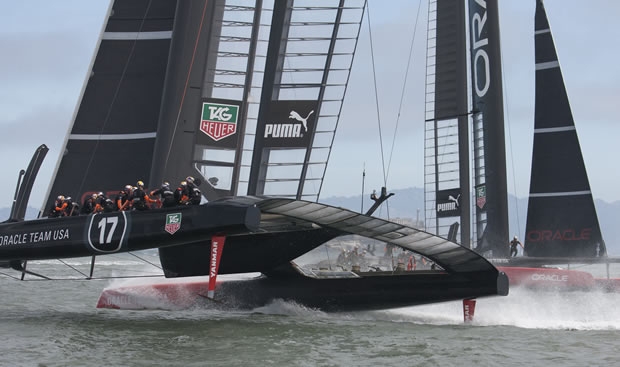
Where next for the America's Cup? Part 2
This article follows on from part one here
Not want Team Principals want
Personally I think even if it was possible to achieve a fully commercial America’s Cup, it is not the way the event should go. Looking back at the event's formidable history, it is not the boats or the sponsors (with the possible exception of Louis Vuitton) that get remembered as much as the billionaires, the captains of industry, those who inherited well or were self-made, who throughout this time have stepped up to compete, be it John Cox Stevens, James Ashbury, Earl of Dunraven, Sir Thomas Lipton, Harold Vanderbilt, Frank Packer, Ted Turner, Alan Bond, Sir Michael Fay, Peter de Savary or at the more recent end of this very long list, Ernesto Bertarelli, Patrizio Bertelli, Larry Ellison, etc. It is with them that the heart of the America’s Cup and its immense history lie. It is elitist and we're okay with that, given that at present there are, give or take, around 1426 billionaires in the world (according to Forbes), more than at any time in the past.
The problem with the new look America’s Cup and its worthy aim of ‘appealing to the Facebook generation’ means the event now no longer appeals to many of the more conservative Team Principles of past America’s Cups. Ironically an exception is long term multihull sailor Ernesto Bertarelli (who, following their costly spate prior to the 33rd America’s Cup, is unlikely to return to the AC – if he returns at all - until Ellison is out). Otherwise the number of billionaires keen on 40+ knot multihulls and willing to back a Cup campaign featuring such boats are few and far between. The high speed, high adrenalin fest of the present America’s Cup is surely better suited to the billionaire ‘kids’, like Mark Zuckerberg, Dustin Moskovitz, Larry Page and Sergey Brins, Elon Musk, etc, although to a man, they are all rich geeks who to date haven’t yet experienced the calling of the sea in the same way as have Larry Ellison, Niklas Zennström and, in the past, OneWorld’s Paul Allen.
Look at the Js!
What we are trying to convey here it best spelled out by a quick look at the J-Class, almost as groundbreaking in the 1930s as the AC72s are today. After Elizabeth Meyer inspired their resurgence almost 30 years ago, today there are seven Js in the water, of which five are regularly racing, while there are another four in various stages of completion. Soon there will be almost as many Js as there were teams contesting the 32nd America’s Cup in Valencia. The build and campaign budgets for Js are similar to America’s Cup budgets from a couple of decades ago and pretty much at the same level as many believe campaign war chests need to be reduced to if the 35th America’s Cup is to be any more popular than the 34th.
So the J-Class owners, including the likes of Netscape founder Dr Jim Clark, and American real estate mogul John Williams (both 70), Roland de Vaal, 60, and TomTom CEO Harold Goddijn, 53, all presumably have adequate financial clout to mount AC campaigns, but have chosen to race an 80 year old version instead. Why? Perhaps it is the grace, beauty and elegance of the Js, today properly classic yachts. They are certainly easy boats to adore. Perhaps their more sedate pace and motion and the less athleticism required to sail them, makes for a more comfortable ride for their owners. Perhaps it is also because the owners get to sail on board their yacht and, as in the cases of the Lionheart, Rainbow and Velsheda, can even occasionally helm them if they so desire...
Perhaps these owners wouldn’t consider an America’s Cup campaign because of the required scale - it is too much of a commitment to something they consider their past-time. Several of the more discreet J-Class owners also wouldn’t wish the limelight that being Team Principle of an AC campaign brings.
But hopefully this illustrates that the route back to a popular, if less ground breaking America’s Cup would be to adopt some sort of good looking monohull. One option would something similar to the 85ft long, 17.5 tonne AC33 box rule monohull that Alinghi was briefly touting for the 33rd America’s Cup, until they got nailed in the New York Supreme Court and the resultant Deed of Gift match ensued. More on-the-ball readers will no doubt recall how Dan Meyer’s 66ft Numbers, a mini version the AC33, seemed to be have conceived by most of Alinghi’s design team and sailed by most of its crew, including at one point even Ernesto Bertarelli, who chartered it for the 2008 Maxi Yacht Rolex Cup.
In fact Numbers ended up being the first benchmark for the fledgling Mini Maxi class. The Mini Maxi would be another good option as an AC35 monohull and - shock, horror - they are even vaguely practical, having an after life as an IRC racer and possibly even some residual value on the secondhand market. This is no small point – that there are 100 ACC yachts plus the two giant multihulls from the 33rd America’s Cup all now effectively scrap, is nothing short of criminal...
It is probably too much to ask for the America’s Cup to be sailed under IRC as the Mini Maxis race are at present with a 72ft maximum length limit. A 72ft America’s Cup monohull would have to be built to a box rule that is IRC-friendly, like the latest iteration of the TP52 rule.
Going box rule Mini Maxi might tempt a number of existing owners to come and play, plus others ‘owners’ from the 32nd America’s Cup who might like to return with boats that personally they can relate to and feel safer on board, than a flying multihull.
Owner driver?
If the organisers really want the 35th America’s Cup to be a success and for it to be in monohulls, then why not encourage owners to drive? This would certainly be possible if a new box rule created boats that were difficult to sail, but easy to steer. In the past we have seen the likes of Artemis Racing’s Torbjorn Tornqvist and Peter de Ridder come out on top against pro helmsmen in the TP52 class. If they were willing to put in the time – why not in the America’s Cup too?
But cats are cool
Oracle has said that their mistake in specifying the AC72 is that it was too large. But really? Given that it is not the hardware where AC teams spend money, but people - would teams really have employed that many less if it had been an AC50 foiling catamaran?
Personally in an ideal world, money be damned, we would like to see AC72s continue to be used as the boat for future America’s Cups. The cat is, so to speak, out of the bag and going back to a fast monohull or a smaller non-foiling catamaran would represent a step backwards in terms of the hardware at least. The hard work with AC72s is over. Yes, they are difficult to launch and retrieve each day, but teams have now got this down to a fine art with various clever ways of ballasting wings, etc and you no longer hear complaints from them about this.
With a few more years of development, AC72s could be made more reliable, their crews could start sailing them to maximum efficiency and they could be raced well. Some refining and tightening of the class rule would improve racing further, cutting off some more design avenues. This is vital to ensure that there is no need to employ 100+ people on the technical side to create and run them (as has been the case this time) thereby reducing budgets.
With the foils being vital to the AC72s flying, the next iteration of the rule should specify a minimum amount of dihedral on the horizontal part of the daggerboards to ensure that, when they are lowered, the boat flies stably. It would be tempting to dispense with the rule banning trim tabs on daggerboards/rudders (that it was hoped would prevent AC72s from foiling, when the present rule was written) so that some sort of wave sensing mechanism could be used to control ride height automatically as a Moth does, but this would probably be an over complication. We’ll have a better idea of how this might be done following the Little America’s Cup, being held immediately after the main event next month, only in Falmouth, UK.
And it is high time someone stood up for the wing. Yes, they are a pain to step and unstep, but once up they hold significant advantages over softsails. No, they aren’t dangerous in strong winds because the top of them can be completely depowered to the extent that it is like reefing. The AC45s and AC72s tack better than other multihulls because the wing doesn’t stall like a mainsail does during manoeuvres.
The wing, together with increased camber in the hulls and optimum balance between the wing’s centre of effort, the boards and rudders, enables AC72s to tack better than any other multihull. To demonstrate why they are so good - in the one moment of match racing in the LVC Final, when Emirates Team New Zealand was successfully tacking to cover Luna Rossa on the beat, her speed never dropped below 10 knots during a series of tacks, something that just wouldn’t happen on most multihulls, not even ORMA 60s... Not for AC72s is getting caught in irons and having to reverse out of tacks.
Significantly, without the wing, foiling gybes are unlikely to be possible.
The problem is the Deed of Gift
Going forwards, the issue, as it always is with the America’s Cup, is the constraint placed on the event by the Deed of Gift. The AC72 might be the right boat for the America’s Cup, maybe America’s Cup racing can be made enticing for the Facebook generation, but this cannot happen, even when backed up by the mighty Ellison dollar, in just one Cup cycle. It can only happen over a longer period, but to make this happen requires continuity, which the Deed seems to not allow.
While at the time of the Ellison v Bertarelli court case there was much talk about establishing some continuity from America’s Cup to America’s Cup, this hasn’t happened and until it does, as Sir Keith Mills stated repeatedly around the time he pulled the plug on TeamOrigin, the event can never be run on a fully commercial basis.
The present system, as laid out under the ‘mutual consent’ part in the America’s Cup Deed of Gift (see below), allows the winner, with the consent of the Challenger of Record, to decide on the nature of the next event. But obviously this only occurs when the winner has won at which point all vital information for the next event, including the venue, date, type of boat, race format, etc is spelled out in their Protocol document. Typically this leaves precious little time to establish commercial partners before the event takes place, concludes and the hiatus begins afresh.
Continuity from Cup to Cup is needed to fix this, bringing the event into the 21st century. We have suggested in the past that Challengers, at the time they sign up to the xth America’s Cup, should be made to agree to some aspects of the x+1th America’s Cup in the event of their winning, even if it is basic aspects like the choice boat, race format, the date and their choice of venue – information that should also be made public. Another clever way of circumventing this, as Brad Butterworth has suggested in the past, is that the winner of the xth America’s Cup (and of course their Challenger of Record) should get to write the rules for the x+2th America’s Cup.
Conclusion
If a maximum number of participating boats is the desire for the next America’s Cup, then the event should return to monohulls, a tight box rule boat, competitive within the Mini Maxi (ie 72ft) or Maxi (100ft) classes. These boats should be designed so that it is feasible for owners to steer them, if they so desire.
If the event is to be sailed in smaller multihulls, then we reckon that the event would be much more competitive, interesting and in particular TV friendly if it were a fleet race. While the America’s Cup is traditionally known as being a match racing event, it shouldn’t be forgotten that the 1851 event round the Isle of Wight was a fleet race as were subsequent America’s Cups – the first match racing America's Cup was the fourth in 1876 between the New York Yacht Club and the Royal Canadian Yacht Club.
A fleet racing America’s Cup could be introduced via the Deed of Gift’s ‘mutual consent’ clause which states: “The Club challenging for the Cup and the Club holding the same may, by mutual consent, make any arrangement satisfactory to both as to the dates, courses, number of trials, rules and sailing regulations, and any and all other conditions of the match...”
Anyway, all will be revealed during the third week of September.

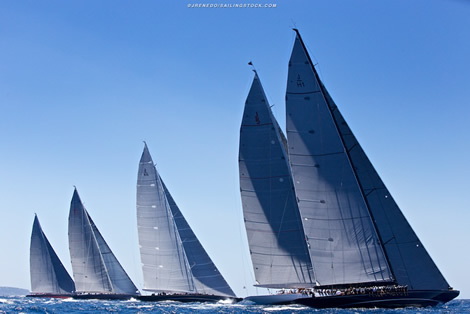
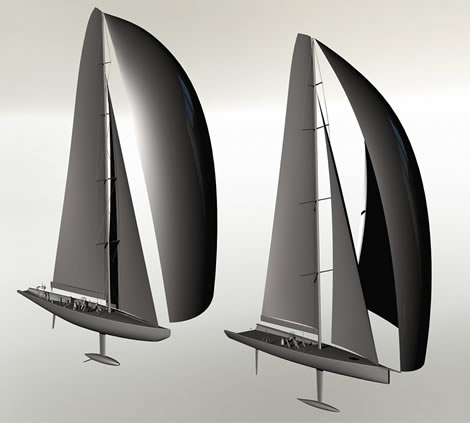
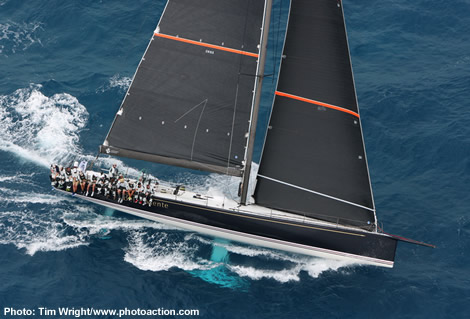
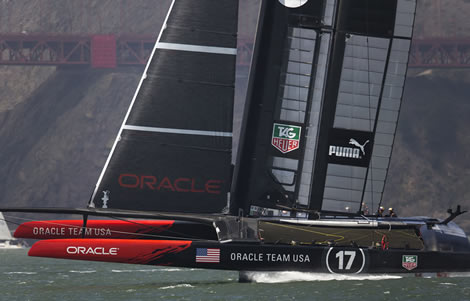
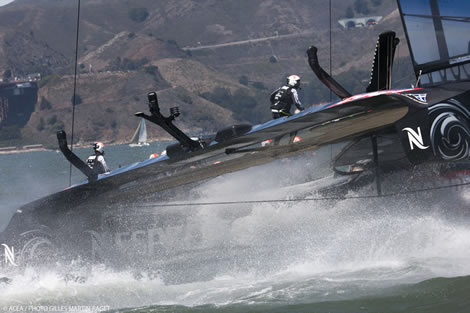







Latest Comments
HieldM 12/09/2013 - 19:18
After watching the first 5 races has proved the move to multihulls has worked in creating a spectacular event for TV equal if not better than other sports and still a tactical boat race, sailing has finally delivered. I hope that who ever wins stays with foiling multhulls, I accept there is a cost particularly as it is less appealing to private owners but one possible way to reduce cost is make the wing sails one design supplied by the event organisers and a slightly smaller multihull say a AC60.Ross Hobson 07/09/2013 - 09:40
OK - so it is match racing - make a dead simple set of rules, my proposal is (as the technology is fun) AC extreme simple box rule: 45ft x 20ft x 80ft – nothing outside the cube (including digital/electronic/wireless connectivity) is allowable at any time. Racing will NOT be cancelled at any time, it is the decision of the skipper/team whether or not to race. You will race the same boat from start of the event to the end with no changes, other than to repair damage These are the rules and also the “spirit of the rules” and any breaches = disqualification with no recourse – bring what you want!edfryer 04/09/2013 - 18:53
Can't be a fleet race. "The match" in the Dog implies match racing - and after the first two challenges, (before the 3rd deed), which were fleet races, AIUI Schuyler made it clear that the regatta should be a match race, and that the word "match" in the MC clause didn't allow fleet racing. In the same way that the minimum length requirement in the DoG had to be changed to allow 12s, despite NYYC and RYS agreeing to their use in the Sceptre challenge.Ross Hobson 01/09/2013 - 18:25
to me its simple use AC 45's, so lots of teams can enter modify the rule so that at least 75% of one hull must be in contact with the water at any time, hence 'banning' foils Fleet racing to chose the top 6, then round robin match racing to decide the semi's and then winner. opp's its no where near expense enough.....Add a comment - Members log in